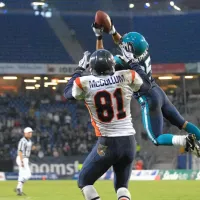Athletic Bilbao, or simply Athletic, is a professional football club based in Bilbao, Basque Country, Spain. Nicknamed Los Leones, they play their home matches at San Mamés Stadium. Their home colors are red and white striped shirts with black shorts. The club's name, stadium, and nickname all tie into local Basque history and culture, specifically referencing Saint Mammes and the church near the stadium.
1901: Founding of Athletic Club
In 1901, a group of Basque students formalized Athletic Club at a meeting held at the Café García, marking the official establishment of the club.
1902: Astorquia Becomes President
In 1902, Juan Astorquia replaced Luis Márquez as president. In the same year, Athletic and Bilbao FC formed Club Bizcaya, winning the Copa de la Coronación.
March 1903: Bilbao FC Absorbed by Athletic Club
On March 24, 1903, Bilbao FC was officially absorbed by Athletic Club, solidifying Athletic's position in the city. The club itself declares 1898 as its foundation date.
1903: First Copa del Rey Title
In 1903, Athletic Bilbao won their first Copa del Rey title, marking an early triumph in the competition. The same year, Basque students formed Athletic Club Madrid after watching the final.
1904: Copa del Rey Win by Default
In 1904, Athletic Bilbao were declared winners of the Copa del Rey after their opponents failed to appear, granting them the trophy without a match.
1907: Club Vizcaya Reaches Copa del Rey Final
In 1907, Athletic Bilbao revived the Club Vizcaya name, entering a combined team with La Union and reaching the Copa del Rey final, but were ultimately defeated.
1910: Copa del Rey Win
In 1910, Athletic Bilbao won the Copa del Rey again, with Luis Astorquia serving as the new captain and goalkeeper.
1910: Athletic Club adopts red and white stripes
In 1910, Athletic Club officially adopted red and white stripes for their jerseys, inspired by Southampton's colors. This change was prompted by Juan Elorduy's purchase of Southampton shirts after being unable to find enough of the previous design in London.
1911: Alejandro de la Sota Elected President
In 1911, Alejandro de la Sota was elected as the 7th president of Athletic Club. He spearheaded the construction of the San Mamés Stadium.
1911: Basque Player Policy
In 1911, Athletic Bilbao adopted a policy of exclusively fielding players native to or trained in the Basque Country. This policy has defined the club's identity and approach to team composition.
August 1913: Pichichi Scores First Goal at San Mamés
On August 21, 1913, Pichichi scored the first goal at the San Mamés Stadium, marking a significant moment in the stadium's history.
1913: Inauguration of San Mamés Stadium
In 1913, the San Mamés Stadium was opened, becoming a symbol of Athletic Bilbao. Alejandro de la Sota was the driving force behind the construction of the stadium.
1914: Copa del Rey Win
In 1914, Athletic Bilbao won the Copa del Rey, marking the beginning of a successful run in the competition. Billy Barnes was the coach.
1915: Pichichi Hat-Trick in Copa del Rey Final
In 1915, Pichichi scored a hat-trick in the Copa del Rey final, showcasing his prolific goalscoring ability.
1916: Copa del Rey Win
In 1916, Athletic Bilbao won the Copa del Rey, continuing their dominance in the competition under coach Billy Barnes.
1917: Institutional Crisis
Between 1917 and 1919, Athletic Bilbao went through a period of institutional crisis, during which the club did not participate in the Copa del Rey.
1919: Institutional Crisis
Between 1917 and 1919, Athletic Bilbao went through a period of institutional crisis, during which the club did not participate in the Copa del Rey.
1920: Return of Billy Barnes
In 1920, Billy Barnes returned as coach, and Athletic Bilbao once again participated in the national championship.
1921: Copa del Rey Win
In 1921, Athletic Bilbao won the Copa del Rey again, marking a return to success for the club with the return of Billy Barnes.
1921: Pichichi Wins Final Championship
In 1921, Pichichi won his last championship with Athletic Bilbao, the Copa del Rey, before his death the following year.
1922: Arrival of Fred Pentland
In 1922, Fred Pentland arrived as the new English coach of Athletic Bilbao. He would later lead the club to victory in the Copa del Rey in 1923.
1922: Death of Pichichi
In 1922, Pichichi passed away at the age of 29, leaving a legacy as a prolific goalscorer for Athletic Bilbao. The La Liga top-scorer is declared the Pichichi in his honour.
1922: First documented use of Athletic's shield
In 1922, the first documented use of Athletic Bilbao's shield occurred. The shield incorporated elements from the escutcheons of Bilbao and Biscay, including the bridge and church of San Anton, wolves from the Haro family, the Gernikako Arbola (Guernica's tree), and the cross of Saint Andrew.
1922: First version of the current crest
In 1922, the first version of the current crest, roughly an inverted triangular shield shape with a section of red-and-white stripes and a section of local motifs, was created.
1923: Copa del Rey Victory
In 1923, Fred Pentland led Athletic Bilbao to victory in the Copa del Rey, revolutionizing the team's playing style with a short-passing game.
1927: Pentland Leaves Athletic
In 1927, Fred Pentland left Athletic Bilbao, marking the end of his first spell with the club. He would later return in 1929.
1928: Founding Member of La Liga
In 1928, Athletic Bilbao became a founding member of La Liga, alongside other Basque clubs such as Real Unión, Arenas Club de Getxo, and Real Sociedad.
1929: Founding Member of Primera División
In 1929, Athletic Bilbao became one of the founding members of the Primera División, and has never been relegated since. Along with Real Madrid, and Barcelona, they are the only clubs to achieve this.
1929: Pentland Returns to Athletic
In 1929, Fred Pentland returned to Athletic Bilbao, leading the club to further success in the following years.
1929: Guillermo Gorostiza Top Scorer
In the 1929-30 season, Guillermo Gorostiza was the top scorer of LaLiga.
1930: Basque Dominance in La Liga
By 1930, five of the ten clubs in the Primera División were from the Basque Country, including Athletic Bilbao and CD Alavés.
1930: La Liga/Copa del Rey Double
In 1930, Fred Pentland led Athletic Bilbao to a La Liga/Copa del Rey double, marking a successful season for the club.
1931: La Liga/Copa del Rey Double and Record Win
In 1931, Fred Pentland led Athletic Bilbao to another La Liga/Copa del Rey double. In the same year, Athletic defeated Barcelona 12–1, the latter's worst defeat in La Liga history.
1931: Bata Top Scorer
In the 1930-31 season, Bata was the top scorer of LaLiga.
1932: La Liga Runners-Up
In 1932, Athletic Bilbao finished as La Liga runners-up, continuing their strong performance under coach Fred Pentland.
1933: Copa del Rey Win
In 1933, Athletic Bilbao won the Copa del Rey for the fourth consecutive time between 1930 and 1933, coached by Fred Pentland.
April 1936: Athletic Wins La Liga Title
On April 19, 1936, Athletic Bilbao defeated Oviedo 2–0, winning the La Liga title two points ahead of Real Madrid.
July 1936: Spanish Civil War Halts Football
In July 1936, football activities were halted due to the outbreak of the Spanish Civil War, impacting Athletic Bilbao and other clubs.
1939: Restart of the League
In 1939, the Spanish league restarted after being halted due to the outbreak of the Spanish Civil War.
1941: Name Change to Atlético Bilbao
In 1941, Athletic Bilbao was forced to change its name to Atlético Bilbao due to a decree issued by Franco. The Copa del Rey was also renamed to Copa del Generalísimo.
1941: First version of current shield created
In 1941, the first version of the current shield was created, but the name "Atlético Bilbao" was used.
1943: Double Win
In 1943, Athletic Bilbao, coached by Juan Urkizu, won a double (La Liga and Copa del Generalísimo).
1943: Athletic Club Wins Title
In 1943, Athletic Club won the title. By this time, Garbutt had been exiled.
1944: Retained Copa del Generalísimo
In 1944, Athletic Bilbao retained the Copa del Generalísimo, continuing their success in the competition.
1945: Retained Copa del Generalísimo
In 1945, Athletic Bilbao retained the Copa del Generalísimo for the second consecutive year, marking a period of dominance.
1946: Lezama Most Unbeaten Goalie
In the 1946-47 season, Raimundo Lezama was the most unbeaten goalie in LaLiga.
1950: Copa del Generalísimo and Copa Eva Duarte Wins
In 1950, Athletic Bilbao won another Copa del Generalísimo and a Copa Eva Duarte (the official precedent of the Supercopa de España).
1950: Zarra's La Liga Scoring Record
In 1950, Telmo Zarra became the top scorer in LaLiga history with 251 goals, a record that stood until 2014.
1954: Daučík retires second historic attack
In 1954, coach Ferdinand Daučík retired the team of second historic attack to give way to a new generation of players.
1955: Copa del Generalísimo Win
In 1955, Athletic Bilbao won the Copa del Generalísimo under coach Ferdinand Daučík, marking another title in the competition.
1956: Double Win
In 1956, Athletic Bilbao, managed by Ferdinand Daučík, achieved a double (La Liga and Copa del Generalísimo).
1958: Copa del Generalísimo Win
In 1958, Athletic Bilbao won the Copa del Generalísimo, beating Di Stefano's Real Madrid in the final. This was considered one of the club's most important achievements.
1969: Copa del Generalísimo Win
In 1969, Athletic Bilbao won the Copa del Generalísimo, improving the team's situation after a period of transition dominated by Real Madrid.
1972: Club adds full color to crest and recovers "Athletic Club" name
In 1972, Athletic Club added full color to the design of their crest and recovered the original English "Athletic Club" name.
1973: Copa del Generalísimo Win
In 1973, Athletic Bilbao won another Copa del Generalísimo, marking a rare moment of success during a less prosperous decade.
December 1976: Public Display of the Ikurriña
In December 1976, before a game against Real Sociedad, Iribar and Sociedad captain Inaxio Kortabarria carried out the Ikurriña (the Basque nationalist flag), placing it ceremonially on the centre-circle. This was the first public display of the flag since the death of Francisco Franco.
1977: UEFA Cup and Copa del Rey Finals
In 1977, Athletic Bilbao reached the final of the UEFA Cup and the Copa del Rey, but lost both. Despite the losses, this is remembered as one of the best teams in the history of Athletic Bilbao.
1981: Javier Clemente Becomes Manager
In 1981, Javier Clemente became the manager of Athletic Bilbao, assembling one of the most successful teams in the club's history.
1982: La Liga Champion
In the 1982-83 season, Athletic Bilbao became La Liga champion after surpassing Santillana's Real Madrid in the standings on the last round.
1985: Third Place Finish in La Liga
In 1985, Athletic Bilbao finished third in La Liga. During the 1985–86 season, Clemente was fired due to a bad relationship with the team's star, Sarabia.
1986: Fourth Place Finish in La Liga
In 1986, Athletic Bilbao finished fourth in La Liga, continuing their run of strong performances in the league.
1995: Signing of Joseba Etxeberria
In 1995, Athletic Bilbao signed Joseba Etxeberria from Real Sociedad, causing bad feelings between the two clubs.
1997: Etxeberria Joins the Squad
In 1997, Joseba Etxeberria was a prominent member of the squad.
1997: Zarra Receives Royal Order of Sports Merit
In 1997, Telmo Zarra was awarded the gold medal to the Royal Order of Sports Merit by the King of Spain Juan Carlos I, recognizing his contributions to the sport.
1998: La Liga Runner-Up and Champions League Qualification
In 1998, coach Luis Fernández led Athletic Bilbao to second place in La Liga, securing qualification for the UEFA Champions League.
2008: Athletic makes deal with Petronor
In 2008, Athletic Club made a deal with the Biscay-based Petronor oil company to wear their logo in exchange for over €2 million, changing their policy on sponsorships.
2008: Slight alteration of the shield shape and introduction of a new typeface
In 2008, the shape of the shield was slightly altered and a new "Athletic Club" typeface was introduced.
2014: Messi Surpasses Zarra's La Liga Scoring Record
In 2014, Lionel Messi surpassed Telmo Zarra's record for the most goals in La Liga history, ending Zarra's long-standing reign as the top scorer.
2016: Valverde leaves, Ziganda Appointed
At the end of the 2016-17 season, Valverde left his position after four years, and former player José Ángel Ziganda was confirmed as his successor.
2020: Messi Surpasses Zarra's Pichichi Trophies Record
In 2020, Lionel Messi surpassed Telmo Zarra's record of six Pichichi Trophies for being the top scorer in La Liga.
2023: Athletic Bilbao wins the 2023-24 Copa del Rey
In 2023, Athletic Bilbao ended their 40-year Copa del Rey drought by winning the 2023-24 Copa del Rey against RCD Mallorca 4–2 on penalties after a 1–1 draw.
2024: Most victories against Real Madrid and Barcelona
As of 2024, Athletic Bilbao has recorded the most victories against both Real Madrid and Barcelona, with 79 wins over Barcelona and 76 over Madrid.
Mentioned in this timeline

Lionel Messi is an Argentine professional footballer widely considered one...
La Liga officially LaLiga EA Sports is the top professional...

Football is a family of team sports primarily involving kicking...

Barcelona is a major city located on the northeastern coast...
Spain officially the Kingdom of Spain is located in Southern...
The UEFA Champions League UCL is an annual club football...
Trending
8 months ago Maldives bans Israelis in solidarity with Palestinians amid Gaza conflict escalation.

3 months ago Brock Bowers' Injury Concerns: Raiders' Crosby Also Added to Injury Report

2 months ago Edison Upgrades South Pasadena Electrical Grid Amidst Storm Recovery, Lifting Evacuation Orders

John Stamos is an American actor and musician who rose to fame as Blackie Parrish on General Hospital earning a...

8 months ago Austin Hays emerges as a top Fantasy Baseball Waiver Wire pickup.

1 month ago Maxxine Dupri, assisted by AJ Lee, dethrones Becky Lynch for Intercontinental Title on Raw!
Popular

Tucker Carlson is an American conservative political commentator known for...

XXXTentacion born Jahseh Dwayne Ricardo Onfroy was a controversial yet...

Ben Shapiro is a prominent American conservative political commentator media...

Candace Owens is an American conservative political commentator and author...

William Franklin Graham III commonly known as Franklin Graham is...

Ursula Gertrud von der Leyen is a prominent German politician...